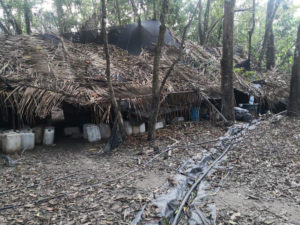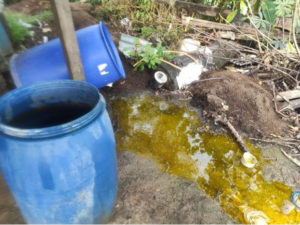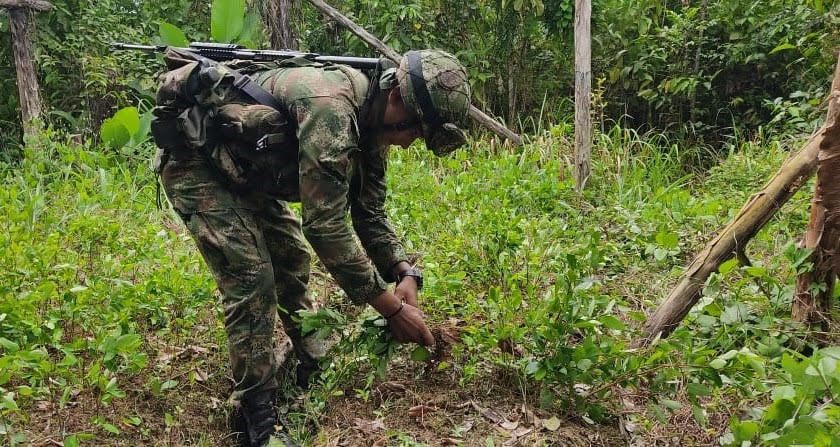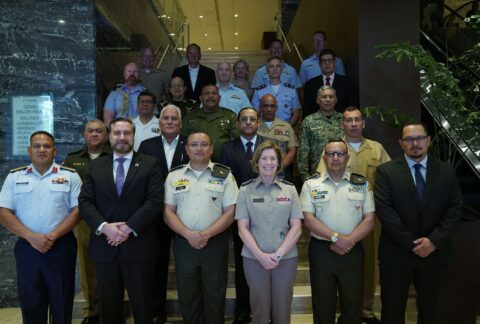Colombia’s Public Force is making resolute headway in the fight against narcotrafficking with ongoing operations fighting all stages of the criminal chain. In late April, the Colombian Navy located and destroyed 20 facilities for illegal cocaine production belonging to dissident groups of the Revolutionary Armed Forces of Colombia (FARC).
The Colombian Navy executed the operations, in southeastern Colombia, in the departments of Putumayo, Meta, Guaviare, and Caquetá, with the support of the National Army, the Colombian Air Force, the National Police, and the Attorney General’s Office. Two of the facilities were cocaine hydrochloride crystallizers, while the others processed coca base paste.

In the illegal facilities, authorities found 3,033 kilograms of solid chemical precursors, more than 34,400 liters of liquid chemical precursors, more than 2,200 kg of cocaine hydrochloride, 448 kg of chopped coca leaves, and 164 kg of coca base paste in process. They also found machinery, equipment, and other items used in cocaine production. In the municipality of Puerto Concordia, Meta department, authorities also destroyed a seedbed with about 4,000 coca plants, the Navy said.
“In the area where these infrastructures were found, the organized armed groups Carolina Ramírez, E 48 Comandos de Frontera, Armando Ríos, Miller Perdomo, and Jorge Briceño Suárez are currently committing crimes,” Colombian Navy Vice Admiral Harry Ernesto Reyna Niño, commander of the Southern Naval Force, told Diálogo. “With the destruction of these facilities, we are hitting the first stage of one of the main sources of income of these FARC dissidents; the laboratories to process coca base paste are part of the production chain to make cocaine hydrochloride, which through narcotrafficking is marketed abroad, therefore financing their criminal activities for the purchase of weapons, ammunition, supplies, and provisions.”
According to data from the Southern Naval Force, so far this year, up to May 17, authorities have neutralized seven ringleaders and 67 soldiers of FARC dissident groups. They have also seized 70 firearms, 1611 kg of explosives, and 33 communication equipment devices.
“Regarding the fight against narcotrafficking, we’ve managed to date the destruction of 133 illegal facilities to process coca paste and make cocaine hydrochloride, [and] 21 seedbeds with a total of 53,500 coca plants,” said Vice Adm. Reyna. “In addition to the seizure of close to $121,659 in cash and $156,419 in smuggled goods.”

The world’s largest producer and exporter of cocaine, Colombia has stepped up the fight against narcotrafficking, seizing nearly 580 tons of cocaine and cocaine base paste in 2020 and nearly 758 tons in 2021, says the U.S. Department of State in its 2022 International Narcotics Control Strategy Report. The U.S. and Colombian governments have a long-standing relationship that includes counternarcotics cooperation and are committed to implementing a whole-of-government approach focused on integrated supply reduction, security, rural development, and environmental protection, the report adds.
“Bilateral cooperation on extraditions, drugs, and money laundering has resulted in hundreds of indictments in the United States and the extradition of high-level drug traffickers,” the report says. Indeed, that cooperation in 2021 led to the capture of Clan del Golfo leader Dairo Antonio Úsaga, alias Otoniel, who was extradited to the United States in early May 2022 to face narcotrafficking charges.









